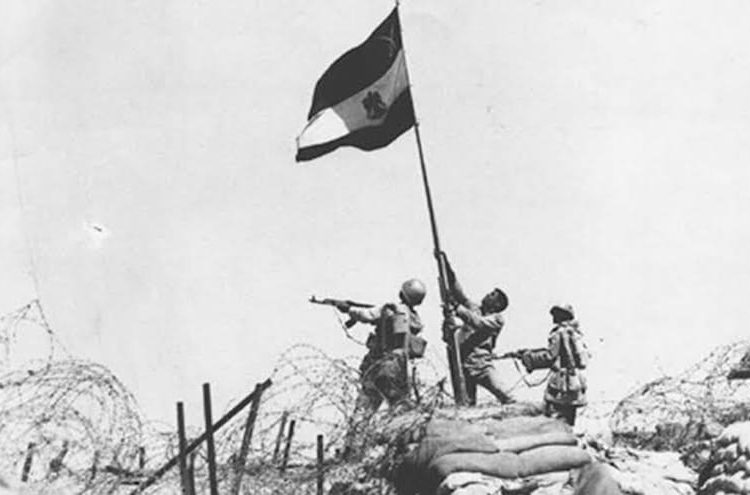By Sarah Saad
The 1973 Egyptian-Israeli war was a turning point in American foreign policy towards the Middle East.
The administration of US President Richard Nixon believed that Israel’s refusal to withdraw from territories it occupied in 1967 would have major strategic consequences for the US.
The war thus paved the way for Secretary of State Henry Kissinger’s shuttle diplomacy and, ultimately, the 1979 Egypt-Israel Peace Treaty.
President Nixon convinced that an Egyptian-Israeli confrontation over the fate of the occupied territories could damage America’s standing in the Arab world and undermine prospects for détente between the US and the Soviet Union.
In an attempt to break the stalemate, he ordered Secretary of State William Rogers to negotiate with the Soviets over the parameters of a Middle East settlement, with the aim of reaching an agreement that each superpower could put together for its regional allies.
By December 1969, the Soviet Union, Egypt and Israel had rejected the so-called ‘Rogers Plan’, which called for the Israelis to withdraw to the 1949 armistice lines, with ‘non-substantive modifications’ in return for peace.
The failure of the Rogers Plan led Nixon to suspend efforts to reach a settlement with the Soviets. It also gave credence to then-National Security Advisor Henry Kissinger’s argument that the US should not push Israel for concessions as long as Egypt, the leading Arab state, remained allied with the Soviets.
In the summer of 1970, Nixon broke with Kissinger and allowed Rogers to advance a limited initiative to stop the Egyptian-Israeli War of Attrition along the Suez Canal.
‘Rogers 2′, which called on Egypt and Israel to agree to a three-month ceasefire and negotiations under the auspices of UN mediator Gunnar Jarring, agreed by both sides and stopped fighting on August 7.
In February 1971, Egyptian President Anwar Sadat presented the Nixon administration with a new opportunity for Arab-Israeli peacemaking.
Sadat proposed that Egypt would reopen the Suez Canal if Israel would withdrew from the eastern bank of the canal and later agreed to a timetable for further withdrawals.
Sadat indicated that he would abandon the war against Israel if Israel withdrew to the international borders.
Rogers’ efforts to capitalise on Sadat’s statements by working towards an interim settlement were rejected by the Israelis. The same efforts received little support from Kissinger and Nixon.
Kissinger believed that Egyptian proposals for a temporary settlement would be rejected by the Israelis, and did not want the dispute over the Middle East to undermine rapprochement efforts with the Soviet Union before the Moscow summit in May 1972.
For Nixon, this reasoning was reinforced by the desire to avoid a crisis in US-Israeli relations before the 1972 presidential election.
Nixon and Kissinger believed that, given the military balance, Egypt and Syria would not attack Israel, a view supported by much of the US intelligence community.
Until the fall of 1973, Nixon and Kissinger believed that any American diplomatic initiative should wait until after the Israeli elections in October.
The war and its consequences
On October 6, 1973, Egypt and Syria attacked the Israeli army in the Sinai Peninsula and the Golan Heights. Kissinger believed that Israel would win quickly.
Thus, he proposed that the US and the Soviet Union call for an end to the fighting and a return to the 1967 ceasefire lines. But the Egyptians rejected the ceasefire proposal.
By October 9, following a failed Israeli counterattack against Egyptian forces, the Israelis called for American support to overcome the defeat.
Not wanting to see Israel defeated, Nixon agreed, and American planes carrying weapons began arriving in Israel on October 14.
On October 16, Sadat began to show interest in a ceasefire, prompting Leonid Brezhnev, former General Secretary of the Communist Party of the Soviet Union, to invite Kissinger to Moscow to negotiate an agreement.
The United Nations Security Council adopted a US-Soviet proposal for a ceasefire followed by peace talks as Resolution 338 on October 22. Kissinger then travelled to Tel Aviv, where he told the Israelis that the US would not object if the Israeli occupation continued to advance while he returned to Washington.
When Kissinger returned to the US, he agreed to a Soviet request for another ceasefire resolution, which the Security Council adopted on October 23.
However, the Israelis still refused to stop. On October 24, Brezhnev sent a hotline message to Nixon suggesting that the US and the Soviet Union send troops to Egypt to implement the ceasefire.
Brezhnev threatened Nixon in case he chose not to do so, saying: “we should be faced with the urgent need to consider the issue of taking appropriate steps unilaterally.”
The US responded by putting its nuclear forces on global alert on October 25. By the end of the day, the crisis abated when the Security Council adopted Resolution 340, which called for a ceasefire and the withdrawal of all forces to their October 22 positions and the United Nations observers and peacekeepers to monitor the ceasefire. This time, the Israeli occupation accepted the decision.
This is how the 1973 war ended with an Egyptian victory, but, at great cost to the United States.
However, it brought the US closer to a nuclear confrontation with the Soviet Union than at any point since the Cuban Missile Crisis (Oct 16 – Oct 29, 1962).
Moreover, the US military air bridge to Israel led Arab oil producers to embargo oil shipments to the United States, some Western European countries, and a number of African countries, causing international economic turmoil.
The Egyptian army destroyed the myth of Israel’s invincible army with a crushing defeat and Egypt regained every inch of its land.






Discussion about this post